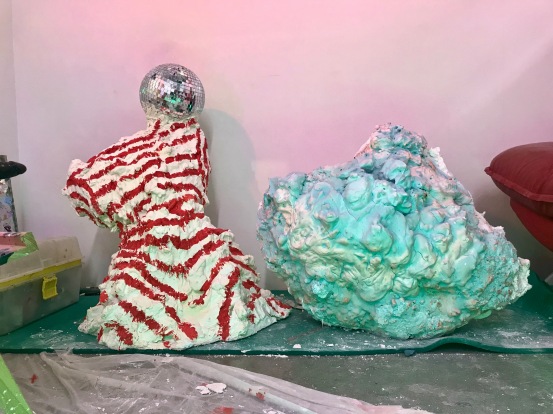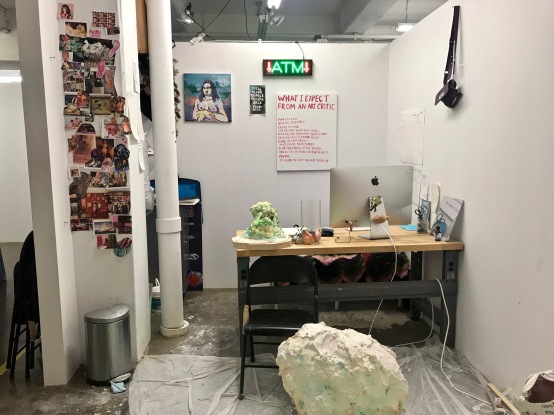
Monika Rostvold is a New York City interdisciplinary artist that makes work about the morality and power of a sexualized woman. Monika was born in Louisville, Kentucky and moved to Texas at a young age where she spent her high school years competing in dance competitions and then achieved her BFA at Texas State University. Her artwork at that time discussed sexual assault on college campuses and the male ego. After moving to NYC she enrolled in SVA for one year, dropped out, and got picked up by Pratt university where she is currently finishing out her MFA.
Monika’s artwork has been the subjects of many debates about the morality of sexual expression and has been discussed/interviewed in Cosmopolitan Magazine, Artnews, and Huffington Post.
“Women are not objects and may do what they want with their bodies.”
First of all, how is New York life treating you?
Very well! I love it here. I just moved out of Chinatown into a huge apartment in Bed Stuy a block away from my studio. I brought my dog with me to NYC and now he has his own backyard which he lives for.
What were some of your battles and victories with your transition from Texas to New York City?
Transitioning was really hard for me my first year. I didn’t realize how much my art was influenced by Texas college’s “university culture” until I left. I looked at my work and discovered that the men I was painting were young fraternity “fuckboys” because that was the kind of characters I was surrounded by in San Marcos. When I came to NYC I was no longer in that culture and searched for new inspiration. I wanted to find men with similar emotional wants and needs as the frat boys so I starting going to BDSM dungeons, online dates, strip clubs, and became friends with sugar babies. I realized that in NYC sex work is extremely common and because of this, there is a lot more consent, respect, and rules within the power dynamic between such men and woman, unlike the rape culture perpetuated on college campuses that have become an epidemic in America.
What was your experience at SVA and why did you change to Pratt?
There was a bunch of reasons why I decided to leave, but I don’t want to talk about them all. One of the biggest reasons why I left was because of the bad energy that was brewing. I openly discussed with my classmates and teachers about my experiences. I wanted to be raw and honest, but I got slut shammed and had extremely inappropriate critiques. My last semester there I didn’t feel comfortable expressing myself and didn’t make any artwork. So I dropped out and didn’t really plan to go back to graduate school at all, but Pratt convinced me to give it one more try.
How has your perception of the art world been influenced by the city?
There is so much happening here all the time just go to the ones you are influenced by or within your network. Chelsea isn’t where the best art in NYC is in my opinion. I prefer the lower east side galleries, or better yet the underground performances.
Can you talk about your background in art and if there was a pivotal moment when you decided to pursue the arts?
My story is a bizarre one, I started painting and drawing when I was really young, like three, became ambidextrous and I drew with both hands at the same time. When I was in junior high I got sent to the principles office because my art teacher accused my mother of plagiarizing my drawings. My mother responded with, “Do you really think I have nothing better to do than to draw my 12-year-old daughter’s assignments?” I was so upset that my teacher accused me of lying and tried to get me expelled that I swore I would never make art again. Fast forward to college, I was less than two semesters away from getting my nutritional degree and was completely unhappy. I had an epiphany where I was like what the fuck am I doing? Do I really want to work at a hospital for the rest of my life where someone is on their death bed and all they want is a cheeseburger and I can’t give it to them? So I quit and asked myself what made me really happy. Even though I didn’t paint or draw since junior high I changed my major to painting. I didn’t tell my family until like a semester later because I was worried they would disapprove. When I finally told my parents they were like “Oh thank god! We were all wondering when you were gonna make art again.” Apparently, they always knew I was going to be an artist.


Can you talk about your most recent performance pieces and what you are focusing on? What are you most interested in today?
I’m still kinda shy and shell-shocked from SVA, but I’m creating a safe space in my studio to perform in and now its become an entire installation. I’m even creating sculptures that will be my “perfect audience”. The aesthetic of the space is inspired by club culture with colored lights, plaster, red leather couches, paintings, reflective surfaces, stuff like that.
What has been your most physically and mentally demanding performance?
I really don’t know. I enjoy it all.
Which performance would you consider least successful? Most successful? And Why?
My least successful performance was in Marfa, Texas. I was commissioned to perform during the Chinati weekend but my performance discussed sex work and what happens when you break the cardinal rule, which is to never fall for a client. Marfa is in the middle of a damn dessert; it just wasn’t the right piece for that kind of crowd.
You are interested in power relationships, subverting and/or exploring them through performance. What do you gain or lose in the process? Insight? Experience?
So, I realized that in undergrad that my paintings and performances were intersectional. I was painting the people that I was meeting and essentially the audience that I was attracting. You can’t be a performance artist if you have no one to perform for so I consider my audience to be an extremely important part of my work but it can’t be just anyone. There has to be an emotional give and take with my audience and me.

Your art is sort of a rebellion, which can then sometimes be perceived as NSFW/shock art. Do you ever take in consideration and/or make choices to ensure your work is SFW/ safe for children? Do you choose galleries and places with this in mind?
My art isn’t for children and when it comes to censorship, I don’t change anything in my work for censorship. I’ve been told by galleries minutes before a performance that I can’t be nude, even though the proposal was approved way ahead of time because they get scared of what people might say or do, but I just do it anyways.
What are your thoughts on shock art? Does it challenge the norm or does it deter progress? What are your thoughts on shock art in relation to your work?
Well, I don’t think my work is shock art at all. Shock art implies that there is disturbing imagery and what is disturbing about a woman using her own body and is in control of her sexuality? I just wrote a philosophical thesis on an art movement I like to call Slut Art which I defined as female artists representing their own sexuality and bodily integrity, abstractly and/or representational, with sex-positive morals to reclaim their bodies and ideals of pleasure. I think Slut Art is extremely important in this moment in time, especially with Trump as president and all of the sexual assault allegations in every industry right now, that women redefine their sexuality their own way and utilize it for their enjoyment and/or pleasure.
Can you talk about the phrase/name of one of your performance pieces “Feminine Fix”? I admire the performance piece and how it also became a zine. I would be interested to learn about any conclusive thoughts you had on this work. Is there a future for it?
So this was inspired by a personal experience that I had on a subway, which is all written in the zine. I was working on the Dancer performance piece and was really contemplating the morality of sex work. When I had the experience on the subway it all made sense and I realized how much people desire even the smallest amount of emotional/physical intimacy. I called this pieces feminine fix because everyone craves attention from a pretty women and everyone goes about different ways to fulfill that fix.
While some pieces are more confrontational than others, as well as varying degrees of social interaction/participation, is there a thrill for you in this, in the unexpected?
For sure, sometimes I like the audience reactions to be raw and not contrived by a gallery setting. I feel when I’m performing I also become a voyeur and watch the audience’s reactions. I learn from them as they learn from me and it becomes a very intimate experience.
Can you talk about your concept behind Dancer, 2016?
Dancer was a month-long performance piece where I worked twelve shifts at one of the worst/oldest gentlemen clubs in Manhattan. I kept as much documentation as I could, wrote short stories, and painted twenty portraits of customers by memory.
This concept began when I was in my search for muses/ inspiration and I was completely enthralled by how open and vulnerable these men were. All of them were searching for that ‘feminine fix’ but it was more innocent and emotional than I expected it to be. Also, I felt more in control, safer from assault, and respected than I ever felt outside of the club. That is because I created rules that the customers abided by and if they didn’t listen there were instant consequences. Afterwards, my thoughts about sexuality, social morality, and body integrity completely changed.
In your zine and performance Feminine Fix, 2017, there is an embrace of the femme in being present. I was not there to see it but it reminded me of Marina Abramovic’s The Artist is Present, except here there is a focused specificity on womanhood and social intervention. Are you exploring this side of yourself and of your work? Are they separate things?
I discovered how my perception of my own sexuality was heavily influenced by societies moral constructs, internalized misogyny within feminism, and whorephobia. Now I’m completely relearning my body, redefining my own idea of beauty and sexuality and figuring out what I want to use it for. With this being said, I don’t think there is a formula for how to be an empowered woman, you have to figure that out for yourself. Everyone has their own way of self-expression and that is ok and needs to be respected.
Any plans for 2018?
I’ve been wanting to work with the curators of Stigma Unbound which is a sex workers and allies performance art series, and once I finish my installation I want to create performances and video pieces within it. Also, I’ve been working on a big project for a while now and hopefully it’ll be done the summer of 2018.


I was there in Marfa, Texas and Monika’s art performance was incredibly profound and deemed the most successful art performance that weekend excluding an amazing performance by Solange the next day. Monika is a perfectionist who was given an ultimatum to alter her performance piece 2 hours before the scheduled performance. She “stuck to her guns” and went through with it without compromise. It was incredible.
LikeLike